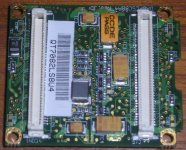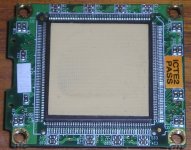Trash80toHP_Mini
NIGHT STALKER
Curious, I'll have dive back into the PDF docs once again it seems.
It's looking like my theoretical interstitial QFP to BGA adapter could be the way to go. The cache deprived 1400/117MHz processor card would be the best candidate as there would be no slow L2 cache complications. Only two tiny caps stand in a 23mm wide pathway between another two pairs of caps into the "cache overhang" space of the higher end processor cards with cache. A pair of holes in the adapter PCB takes care of that clearance problem with plenty of area left on the multiple layers for the lines required for support components/voltage doohickeys.
The only complication would be that such an extension buries the QFP pads on that side of the adapter. Such may not be a problem as higher temperature hot air installation would be possible. There are ZERO active components on the processor card. Every component is a silk screen layer identified cap, resistor or resistor pack save a curious boxy two connection somethingorother. I'll need to buz the connections, WAG would be a voltage converter?
This brings up a second approach that's nontrivial at best and outright insane at worst. The 117MHz card appears to be done in four layers and amounts to an interboard connectors to QFP adapter with a workable sprinkling of power leveling and termination(?) glue on board. Caffeine deprived morning musing today would be to design a new processor card for the BGA G4 of choice with cache on die instead of the interstitial adapter. As in the statement above, the cantilevered "cache extension" provides more than adequate PCB real estate for support components.
If the high 32 bits of a 64bit CPU were terminated would that suffice to use such a beast on a 32bit bus? We're talking shades of the LC's lamed 32bit 68020 running on a 16bit bus. A two generation CPU upgrade with cache on die at a HIGH bus multiplier on the 1400's 32bit bus hardly qualifies as "laming." [} ]
]
I hope this makes some kind of sense? :blink:
*** I'm beginning to wonder if Wegener employed an interstitial BGA to BGA adapter for theig Pismo G4 upgrades?
edit: designing a new processor card with CPU specific support components would almost have to be a more practical approach (and far more efficient) than an interstitial adapter board. BGA to board interconnects on either side has to be easier than the spaghetti mess of BGA to QFP pads on all four sides. I wonder if the interboard connectors are still available? Donor card harvest/reinstallation on the G4 adapter ought to be easy enough, no?
It's looking like my theoretical interstitial QFP to BGA adapter could be the way to go. The cache deprived 1400/117MHz processor card would be the best candidate as there would be no slow L2 cache complications. Only two tiny caps stand in a 23mm wide pathway between another two pairs of caps into the "cache overhang" space of the higher end processor cards with cache. A pair of holes in the adapter PCB takes care of that clearance problem with plenty of area left on the multiple layers for the lines required for support components/voltage doohickeys.
The only complication would be that such an extension buries the QFP pads on that side of the adapter. Such may not be a problem as higher temperature hot air installation would be possible. There are ZERO active components on the processor card. Every component is a silk screen layer identified cap, resistor or resistor pack save a curious boxy two connection somethingorother. I'll need to buz the connections, WAG would be a voltage converter?
This brings up a second approach that's nontrivial at best and outright insane at worst. The 117MHz card appears to be done in four layers and amounts to an interboard connectors to QFP adapter with a workable sprinkling of power leveling and termination(?) glue on board. Caffeine deprived morning musing today would be to design a new processor card for the BGA G4 of choice with cache on die instead of the interstitial adapter. As in the statement above, the cantilevered "cache extension" provides more than adequate PCB real estate for support components.
If the high 32 bits of a 64bit CPU were terminated would that suffice to use such a beast on a 32bit bus? We're talking shades of the LC's lamed 32bit 68020 running on a 16bit bus. A two generation CPU upgrade with cache on die at a HIGH bus multiplier on the 1400's 32bit bus hardly qualifies as "laming." [}
I hope this makes some kind of sense? :blink:
*** I'm beginning to wonder if Wegener employed an interstitial BGA to BGA adapter for theig Pismo G4 upgrades?
edit: designing a new processor card with CPU specific support components would almost have to be a more practical approach (and far more efficient) than an interstitial adapter board. BGA to board interconnects on either side has to be easier than the spaghetti mess of BGA to QFP pads on all four sides. I wonder if the interboard connectors are still available? Donor card harvest/reinstallation on the G4 adapter ought to be easy enough, no?
Last edited by a moderator:



